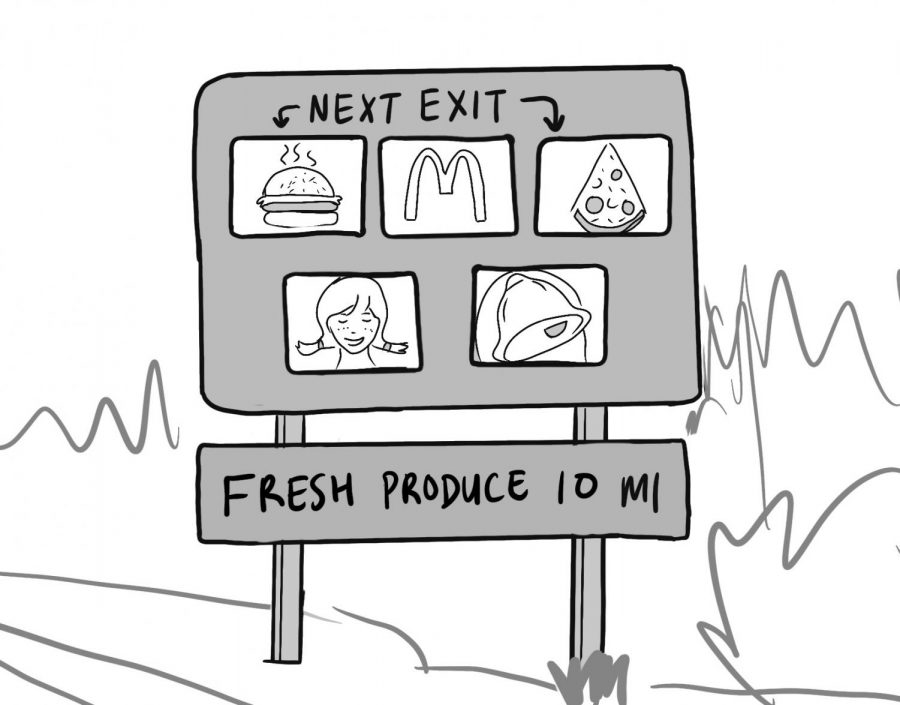Food deserts exacerbate socioeconomic disparities during the pandemic
April 28, 2021
At the beginning of the COVID-19 pandemic, grocery stores were left barren as people scrambled to buy as many toilet paper rolls and nonperishable foods as possible. While wealthier individuals had fewer budgetary concerns as they made these purchases, others found it difficult to draw from the minimal savings they had to compete with the rate at which people were purchasing these items.
The first months of the pandemic ascertained one fact: the existing socioeconomic disparities among Americans would become more pronounced. These inequities engendered by a failing capitalistic system present far too many barriers for lower socioeconomic groups to access healthy food options, which is exceedingly evident in the food deserts of New York City.
Based on data from 2017, NYC Health reports 78.3% of the wealthiest neighborhoods in New York City agreed that their household had enough kinds of foods they wanted in the last six months. This percentage significantly decreases with the impoverishment of the neighborhoods: 69.8% of the medium poverty, 65% of the high poverty and 59.8% of the very high poverty neighborhoods agreed with this statement.
People need and deserve a robust array of dietary options from which to make good choices concerning their health.
Food deserts are areas wherein healthy food is less accessible due to an abundance of fast-food restaurants and a shortage of supermarkets. Most food deserts are in low-income neighborhoods.
Affordability and convenience are often the greatest barriers to maintaining a nutritious diet, both of which are seldom offered by supermarkets selling quality produce in food deserts. People in impoverished communities, instead, are attracted to the ample variety of fast-food chains from which they can quickly order a satiating meal at a low price, drawing these companies into these communities to set up shop.
Of the New Yorkers who were able to walk five minutes or less to purchase produce in 2014, 78% of them ate one to four servings of fruits and/or vegetables. Also, 77.6% of those who lived between five to 10 minutes and 77.2% of those who lived 10 minutes or longer from where they access produce consumed this same number of servings on average.
During the pandemic, the distance of these supermarkets present issues for residents who are apprehensive to leave their homes for too long out of fear of contracting COVID-19, forcing many to turn to their local delis or fast-food restaurants, where there is less-nutritious food.
Supermarkets may not offer the same degree of convenience or affordability as McDonald’s or Popeyes, but eating nutritious food is pertinent to one’s health. Even more, all people are deserving of access to healthy food and the capacity for good health, which should be more closely associated with human rights than privileges only awarded to those who can afford the costs.
As a result of the increased food insecurity brought on by the COVID-19 pandemic, the city government has tried to take action through food assistance programs.
“Food banks have been a crucial lifeline for the family, and that sometimes it can be difficult just to get toilet paper and other basic items, because they either don’t have money for it or there is no availability in stores,” a Corona, Queens resident who became unemployed at the beginning of the pandemic told The Guardian.
The CUNY School of Public Health COVID-19 Survey found that 30% of respondents used some emergency food assistance programs between April and November 2020, expanding from the 16% who typically receive these services during non-pandemic times.
The expansion of these programs raises questions about the feasibility of maintaining the level of assistance for communities that need them, especially since people will likely feel the financial losses incurred due to unemployment caused by the COVID-19 pandemic for a while to come.
Pantries and food delivery services demonstrate how the government could intervene in food deserts, bringing healthy options directly to communities. Supermarkets offer healthier choices than fast-food or delis, but new developments like Trader Joe’s run the risk of gentrifying these neighborhoods and copious residents would not be able to afford their prices, anyway.
Even though greater food assistance requires the reallocation of federal, state and city funding, the pandemic has demonstrated that there are realistic actions that can be taken to weather away at the barriers that perpetuate the existing social inequities found in food deserted neighborhoods.
The Supplemental Nutrition Assistance Program, or SNAP, provides food stamps to individuals to supplement their low income enough to afford groceries, but this issue of access still exists.
To expand the accessibility of healthy food options, the U.S. Department of Agriculture began a program in 2019 where people could use their SNAP benefits for online delivery. This program further exemplifies how the government could bridge the gaps between affordability, convenience and healthiness.
Offering adequate, nutrition-oriented food services to food deserted communities is not only critical to reducing food insecurity and improving public health but also feasible now that the pandemic has brought legitimate, innovative action to address socioeconomic inequities.







